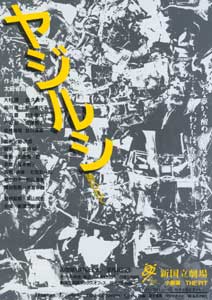|
|
 |
Yajirushi (Arrow) - Being Tempted
THE PIT |
| <STAFF> |
| |
| Written and directed by |
: Ota Shogo |
| Set Designer |
: Shima Jiro |
| Lighting Designer |
: Ogasawara Jun |
| Sound Designer |
: Kato Yoichiro |
| Costume Designer |
: Domoto Noriko |
| Sound and visual production |
: Ota Genichiro |
| Assistant Director |
: Maeda Manami |
| Stage Manager |
: Yonekura Yukio |
| |
|
| Artistic Director |
: Kuriyama Tamiya |
| Presented by |
: New National Theatre, Tokyo |
|
| <CAST> |
| |
| Osugi Ren |
|
Kim Kumija |
| Shinagawa Toru |
|
Inagawa Miyoko |
| Oda Yutaka |
|
Suzuki Rieko |
| Yoshida Asahi |
|
Ando Tomoko |
| Kanai Yoshinobu |
|
Tanigawa Kiyomi |
|
| <PERFORMANCES> |
| |
November
2002 |
Tue.
12 |
Wed.
13 |
Thu.
14 |
Fri.
15 |
Sat.
16 |
Sun.
17 |
Mon.
18 |
Tue.
19 |
Wed.
20 |
Thu.
21 |
| matinée |
|
|
|
|
1:00pm |
1:00pm |
No
Performance |
|
2:00pm |
|
| evening |
7:00pm |
7:00pm |
7:00pm |
7:00pm |
|
|
7:00pm |
|
7:00pm |
November
-December
2002 |
Fri.
22 |
Sat.
23 |
Sun.
24 |
Mon.
25 |
Tue.
26 |
Wed.
27 |
Thu.
28 |
Fri.
29 |
Sat.
30 |
Sun.
1 |
| matinée |
|
1:00pm |
1:00pm |
No
Performance |
|
2:00pm |
|
|
1:00pm |
1:00pm |
| evening |
7:00pm |
|
|
7:00pm |
|
7:00pm |
7:00pm |
|
|
Doors will open 45 minutes before the start of each performance. |
| <ADVANCE TICKETS> |
| |
Available from Sunday 29 September, 2002 at 10:00am.
To order tickets, please call +81-3-5352-9999 (10:00am-6:00pm).
Internet ticket reservation available through the following Websites.(Japanese only)
http://t.pia.co.jp/
http://eee.eplus.co.jp/ |
| <TICKET PRICES> |
| |
| Type |
Seat A |
Seat B |
| Price |
¥4,200 |
¥3,150 |
Seat Z(¥1,500) is sold only on the performance day at the Box Office and exclusive Ticket Pia Offices.
|
 There is no happier moment than when coming
out of an unpleasant dream.
There is no happier moment than when coming
out of an unpleasant dream.
In other words, I am happy now.
Contemporary drama in Japan took on a quite different look in the 1960s. Supported by the worldwide trend of criticism at the postwar systems, young theatrical people launched small avant-garde theater companies one after another in rivalry with the shingeki (new theater) establishment. Looking for new theatrical concepts, these people led their respective groups as a charisma of strong individuality, brilliant talent and tremendous influence and attracted public attention not only in Japan but also in the rest of the world. Ota Shogo, together with Kara Juro, Suzuki Tadashi, Terayama Shuji and Betsuyaku Minoru, is viewed as a member of the first generation of the movement called "shogekijo undo (small theater movement)."
From 1970 to 1988, Ota Shogo presided over the Tenkei Gekijo theater
company established in 1968. He established his own style, called "silent
drama," which reduced the lines to a minimum. With its focus on physical
movements, silent drama looked at the lives of people living in this world
and human beings as a biological existence in simple theatrical space, sound
effects and the amplified flow of time. "The fervent performance of people
living in modern times," "A whirlpool of abundant images," "Opulent theatrical
performance," "The essence of drama," "Stage direction that explored new
dramatic possibilities" and "The theatrical beauty that came home to the
viewers" - all these comments that were made on the stage direction by Ota
Shogo ask us sharp questions: What is drama and what is something dramatic?
The motif of "Yajirushi (Arrow) - Being Tempted" is an arrow that
appears at the beginning of Kosmos (Cosmos), a novel by the Polish
writer Witold Gombrowicz. The arrow is a symbol that simply indicates a
direction and has an unknown purpose. The world of twilight in which men
and women driven by arrows that suddenly appear meet, as well as memory,
the lives of human beings& In the Yajirushi series, Ota Shogo previously
wrote three dramas: Yajirushi in 1986, Mizu no Kyujitsu (The
Holiday of Water) in 1987, and Element in 1994. In these works, he
intentionally quoted and repeated the lines written and spoken in various
ways, and this technique fused spatial and temporal structures to create
a dramatic universe. In addition to human beings as a biological existence,
he attempted to shed light on human beings as a social existence and portray
both aspects of human beings, and this perspective can only be seen in the
Yajirushi series, which explores the possibilities of text as a tool.
Objects, images, sounds and text - all these tools interact with one another
to create the dramatic world of Ota Shogo. Look forward to his new work,
the culmination of the Yajirushi series he has worked on during the
past 20 years. |



|
|

 There is no happier moment than when coming
out of an unpleasant dream.
There is no happier moment than when coming
out of an unpleasant dream.